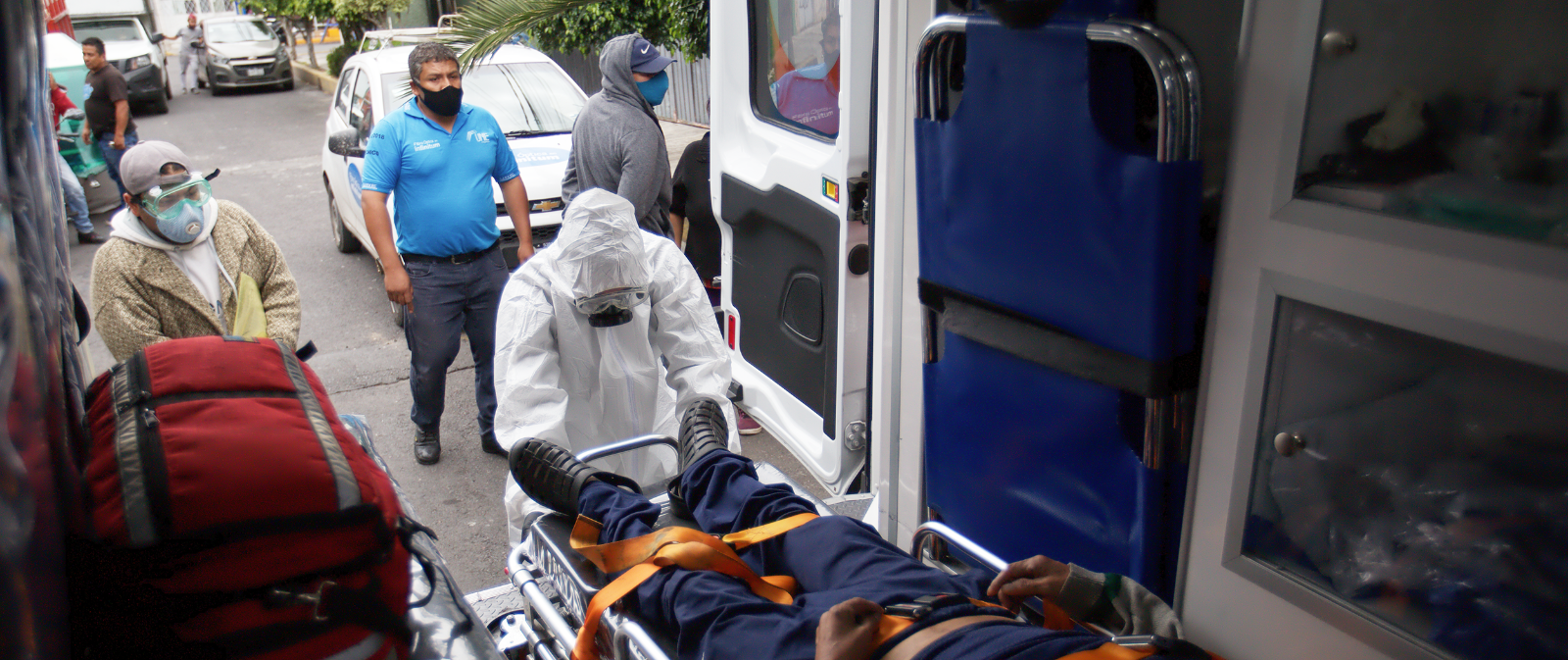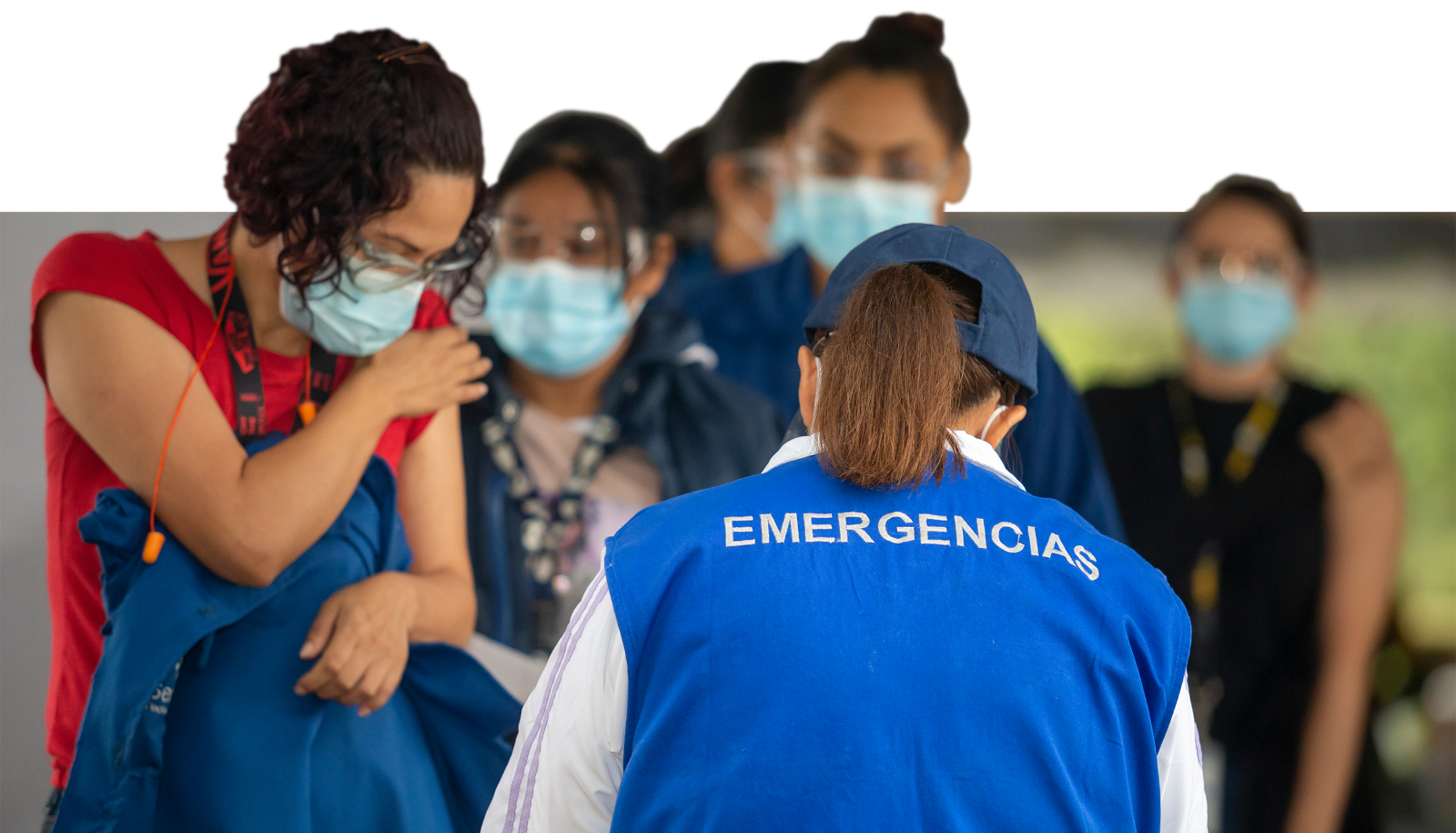3
Crisis, Resilience, and Recovery
The Crisis
The LAC region has been affected by the pandemic more intensely than any other region in the world. About 17% of reported COVID-19 cases and 29% of confirmed deaths have occurred in this region, which has only 8% of the world’s population. The region’s economies contracted by 6.7% in 2020 – almost twice the average global decline of 3.5%. An estimated 30 million people lost jobs between February and June 2020 (IDB b, 2021); over 55 million people have been impoverished (IDB c, 2021); and around 120 million children lost an average of a year of schooling, representing a loss of 6.3% to 10.5% of GDP (López Bóo et al., 2020). The pandemic essentially generated a triple crisis: in health, in the economy, and in society.

Video
The faces of the health sector during the crisis: the pandemic, as
seen by the front line responders.
Countries in the region knew that COVID-19 was on its way after watching it spread from Asia to Europe and the United States. By April 1, 2020, most LAC countries had implemented stringent containment and closure policies to try to stop the pandemic (Oxford Covid-19 Government Response Tracker). Similar policies seemed successful at slowing the pace of infections and deaths in the United States and Europe during the second quarter of 2020, but the level of transmission remained high in LAC for a longer period than in other countries (OECD, 2020).
The region’s health systems were not prepared for such a quickly moving pandemic. The initial response was hindered by limited capacity for testing, contact tracing, and establishing isolation and quarantine protocols. Most countries simply lacked sufficient equipment, laboratories, supplies, information systems, personnel, and planning for an effective response.

A second wave of limitations became apparent as people with severe cases overloaded hospitals and intensive care units. It was difficult to properly diagnose people without adequate testing, but of greater urgency was the limited capacity to provide ventilators and hospital beds for patients and protective equipment for health workers. In some places, people were turned away from hospitals, and news reports recounted difficulties in properly transporting and burying corpses (BBC,2021; New York Times, 2020).
The health system faced additional crises as the pandemic unfolded. Many countries suspended routine health care services and postponed nonurgent surgeries and treatments. Even emergency services unrelated to COVID-19 were curtailed in many places when governments shifted resources to address the pandemic or when people avoided using health care services out of fear of infection. In a WHO survey conducted in the first quarter of 2021, 55% of LAC countries reported interruptions in services provided at the primary level of care and 20% registered some type of interruption in the provision of emergency services.
In most countries, preventive care, including vaccinations, cancer screening, and management of chronic conditions, declined sharply during 2020. For the region as a whole, vaccination coverage during 2020 for tuberculosis (BCG); diphtheria, tetanus, and pertussis (DTP); measles; and polio, was roughly equivalent to levels from over 20 years ago (Technical Note: Going Beyond Normal, 2022).
Despite the surge in COVID-19 cases, overall use of hospital care fell in many countries. In Brazil, El Salvador, and Mexico, hospitals’ discharges fell between 11% and 41% for patients with diabetes mellitus, between 13% and 58% for those with hypertensive disease, and between 16% and 63% for those with ischemic heart disease. Although these declines could indicate that fewer people had these diseases, it is more likely that people chose not to seek treatment or that hospitals were too busy attending to COVID-19 patients to admit them. Fortunately, most of the region maintained care for pregnant women, with few declines in professionally attended births and modest reductions in antenatal care (Technical Note: Going Beyond Normal, 2022).
FIGURE 3: CHANGE IN TOTAL PUBLIC HOSPITALIZATIONS DUE TO PANDEMIC: 2020 VS. 2015–2019 (THOUSANDS)
During 2020, the region’s health worsened, although some groups and conditions saw improvements. Mortality rose sharply in 2020 not only because of COVID-19 cases but also because of the pandemic’s indirect effects. In 17 LAC countries, over 800,000 more people died in 2020 than in previous years (The Economist Tracker).
Deaths from NCDs generally rose. Brazil, Chile, and El Salvador reported more deaths from diabetes mellitus, an increase of 14%. Deaths from hypertension rose by about 11% in Brazil and Chile but grew by 49% in El Salvador. The causes behind these increases in mortality from chronic conditions are not well understood but probably were a combination of disruptions in health care services and complications associated with COVID-19 (Technical Note: Going Beyond Normal, 2022).
FIGURE 4: CHANGE IN DEATHS FROM SELECTED CHRONIC CONDITIONS DUE TO THE PANDEMIC: 2020 VS. 2015–2019
Children’s health worsened in some countries. For example, in Guatemala, almost twice as many children suffered from acute malnutrition in 2020 compared to the average of previous years (Technical Note: Going Beyond Normal, 2022). However, child health continued to improve in other places. For example, during 2020, infant mortality continued to fall in the Dominican Republic and Peru, by 16% and 13%, respectively, relative to historical averages. In Peru, chronic malnutrition also decreased, by about 7%, and the prevalence of anemia in children under five years of age fell by almost 11%.
Overall, maternal health faced increased risk. Mexico, Colombia, and Peru reported increases in maternal mortality, which were largely attributable to complications related to COVID-19 among pregnant women. Some studies have also shown that pregnant women have become more likely to develop depression and anxiety since the start of the pandemic (Berthelot et al., 2020; Liu et al., 2021; Medina-Jimenez et al., 2020).
Resilience
The region had to adapt quickly to face the pandemic. Governments, health care workers, private-sector firms, and communities all responded in numerous ways. Governments struggled to acquire necessary supplies by passing emergency legislation to allow nonconventional procurement approaches. Medical staff were retrained and reassigned to infection treatment wards. Other kinds of health and community workers were trained and deployed for testing and contact tracing.
Physical infrastructure was reorganized to limit the spread of infection. Other facilities —such as arenas, summer camps, and hotels— were repurposed as field hospitals or quarantine sites. Health care providers were allowed and often encouraged to offer consultations by telephone or computer —often referred to as telemedicine— as a way to prevent potentially infectious contact and maintain other health care services (García Zaballos et al., 2020; Figure 5).
New medical protocols for treating serious cases of COVID-19 were developed around the world and then rapidly communicated to and adopted in the region. For example, health care practitioners initially thought that patients with breathing difficulties should be placed on ventilators as soon as possible. Subsequent experience and research showed that other techniques, some as simple as placing a person face down on their stomach instead of their back (i.e., proning), could lead to better outcomes while reducing demand for scarce ventilators.
The region was slow to expand COVID-19 testing, in part because of limited equipment, supplies, laboratories, and trained personnel. As the world gained experience with this new disease, the region adopted techniques to make better use of limited resources for testing and contact tracing. For example, some countries used pooled testing, which made it possible to use a single test kit for a group of people. Many countries also promoted the use of smartphone apps to obtain information about contact with infected people and symptoms in order to improve the speed and effectiveness of contact tracing (Smarter Crowdsourcing: Coronavirus 2020).
FIGURE 5: USE OF TELEMEDICINE IN SELECTED COUNTRIES IN LAC REGION
CHILE
URUGUAY
Source: Authors’ calculation based on administrative records from the National Integrated Health System (SINADIS, in its Spanish acronym) in Uruguay, and Supersalud in Chile.
Recovery
COVID-19 is still taking its toll on the region, but several factors have helped countries reduce the death toll and resume health care services. During 2020, governments mobilized substantial funding for pandemic response. The average fiscal package in the region was 8.5% of GDP, which offset declines in economic activity, expanded social welfare and cash transfer programs, and financed critical health services. Part of this spending (or commitment to spend) included advance purchase commitment agreements during 2020, which played an important role in obtaining access to life-saving vaccines in 2021 (Amrita et al., 2020).
The arrival of vaccines in 2021 has probably been the most important factor for slowing COVID-19 transmission, reducing the severity of infections, protecting health care workers, and resuming health care prevention and treatment. The initial rollout of vaccines in the LAC region was slow, but by the end of 2021, almost half of the region’s population had received the required vaccine doses. Brazil, Colombia, Costa Rica, Ecuador, Nicaragua, Panama, Peru, and Uruguay vaccinated over three-quarters of their populations. Argentina (90%) and Chile (93%) achieved vaccination coverage that exceeded the OECD average (77%). Some countries, however, continue to lag, with vaccination coverages below 50% of their populations.
Finally, health care systems eventually re established supply chains, obtained more supplies and diagnostic equipment, adopted new technologies and re-engineered protocols to handle the new challenges posed by the pandemic. As a result, some health care services have resumed their historical levels. For example, in El Salvador, cervical cancer screening reached its pre-pandemic levels by the end of 2020, but the decline during most of the year created a backlog. Nevertheless, many health care services remained below their historical levels. For example, care for diabetes and hypertension were 16.7% and 23.4% lower than the historical averages in Ecuador.



